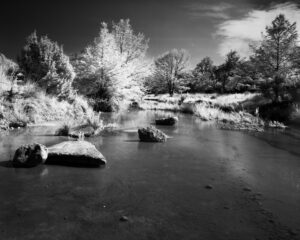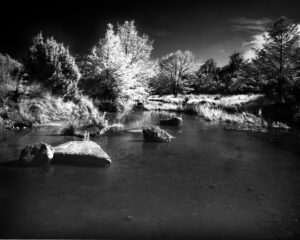As I’ve been slowly getting into 8×10 large format photography, I’ve been wanting an 8×10 infrared film stock since I really enjoy taking IR photos using Rollei IR 400 in 4×5 (even with some of the annoying caveats). Until recently, I didn’t think there was an available solution (apart from super expired and expensive film), and while there’s varying opinions about whether FN64 is still being manufactured, it is available “new” from Astrum (a Ukranian based photographic company, of note). I managed to get my hands on some to test by way of a group buy and thought I would provide my initial findings:


These were taken minutes apart using an R72 filter and metered the same way. I bracketed 5 and 6 stops so for FN64, I rated it at an effective ISO of 1 and 2; and for Rollei IR 6 and 12. Oddly the Rollei came out a but underexposed and I also under-developed it slightly. That may explain why it seems to have a more dramatic appearance. Both were developed in Adox XT-3 (Replenished) in my DIY rotary. I picked the 1 ISO shot for FN64 and the ISO 6 for Rollei IR (more on that in a bit).
These images have been “dodged and burned” in Lightroom but with similar treatments to both. I wanted to compare results of how I would make an actual darkroom print rather than just a raw scan, although the raw scans aren’t too far off – I just accentuated the darkened sky a bit more and burned in the water some.
These were both shot in 4×5 – I only have 25 sheets of FN64 in 8×10 and didn’t want to break those out until I have a good working process in 4×5. FN64, like Rollei IR, is on a thin base. This is true for 35mm as well and, though I haven’t opened the 8×10 package yet, I expect it to be on a similarly thin base. That makes for a potentially challenging situation but one I hope I can work with. Being able to make contact prints for an 8×10 IR negative would be quite something!
The results are pretty close I would say. Of course, FN64 has lower grain and, being a much slower shutter speed (I believe 2 seconds), has more movement in the tree leaves though I quite like that. Unfortunately both sheets have some annoying blemishes. The FN64 has what looks like streaks running left to right which can be seen in the sky. I’m not sure if they would print through in the darkroom but they are definitely there in the scan. The Rollei IR has lots of pinholes (also in the sky). Oddly more than I usually get. Similarly, the other sheets from both films had one half of the image slightly darker divided right along the middle. I think this may be an issue in the camera (my Chamonix bellows aren’t fully IR safe and perhaps that’s enough to cause an issue, or there’s an issue with my holders – though I used two different brands for these tests).
I used a pre-wet for both films which I commonly do when using XT-3 in replenishment. For Rollei IR I tend to prefer 510-Pyro and expect that will be a good match for FN64. I started with XT-3 since it’s more economical to do film tests with. That and my last bottle of 510-Pyro seems to have crystalized in a weird way and opted not to risk it for these tests. My plan is to use the DeFehr semi-stand agitation method for both (probably in my SP-8×10 tank) and compare those results. The minimal agitation, I hope, will help avoid the pinholes for Rollei IR (it has helped in the past) and might perhaps avoid those developing streaks.
Thing about IR is there’s more of a guessing game going on since you can’t directly meter for the IR anyway which makes semi-stand development a reasonable trade-off I think. I don’t expect perfectly printable negatives necessarily. In the past using 510-Pyro with Rollei IR has made for some fairly easy to print negatives though and I hope FN64 will prove to be the same. If so, it might just be the solution I’ve been looking for in 8×10!
That is until Ilford finally decides to offer SFX 200 in sheets…. (that’ll be the day!)
